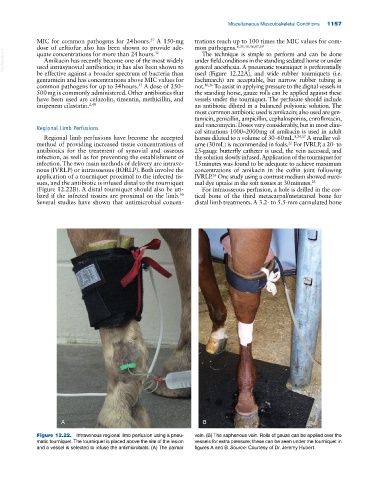Page 1191 - Adams and Stashak's Lameness in Horses, 7th Edition
P. 1191
Miscellaneous Musculoskeletal Conditions 1157
MIC for common pathogens for 24 hours. A 150‐mg trations reach up to 100 times the MIC values for com
27
dose of ceftiofur also has been shown to provide ade mon pathogens. 6,35,40,46,47,59
VetBooks.ir used intrasynovial antibiotics; it has also been shown to under field conditions in the standing sedated horse or under
The technique is simple to perform and can be done
quate concentrations for more than 24 hours.
32
Amikacin has recently become one of the most widely
general anesthesia. A pneumatic tourniquet is preferentially
be effective against a broader spectrum of bacteria than used (Figure 12.22A), and wide rubber tourniquets (i.e.
gentamicin and has concentrations above MIC values for Eschmarch) are acceptable, but narrow rubber tubing is
common pathogens for up to 34 hours. A dose of 250– not. 10,26 To assist in applying pressure to the digital vessels in
51
500 mg is commonly administered. Other antibiotics that the standing horse, gauze rolls can be applied against these
have been used are cefazolin, timentin, methicillin, and vessels under the tourniquet. The perfusate should include
imipenem cilastatin. 2,48 an antibiotic diluted in a balanced polyionic solution. The
most common antibiotic used is amikacin; also used are gen
tamicin, penicillin, ampicillin, cephalosporins, enrofloxacin,
and vancomycin. Doses vary considerably, but in most clini
Regional Limb Perfusions
cal situations 1000–2000 mg of amikacin is used in adult
Regional limb perfusions have become the accepted horses diluted to a volume of 30–60 mL. 8,24,37 A smaller vol
method of providing increased tissue concentrations of ume (30 mL) is recommended in foals. For IVRLP, a 20‐ to
22
antibiotics for the treatment of synovial and osseous 25‐gauge butterfly catheter is used, the vein accessed, and
infection, as well as for preventing the establishment of the solution slowly infused. Application of the tourniquet for
infection. The two main methods of delivery are intrave 15 minutes was found to be adequate to achieve maximum
nous (IVRLP) or intraosseous (IORLP). Both involve the concentrations of amikacin in the coffin joint following
application of a tourniquet proximal to the infected tis IVRLP. One study using a contrast medium showed maxi
24
sues, and the antibiotic is infused distal to the tourniquet mal dye uptake in the soft tissues at 30 minutes. 23
(Figure 12.22B). A distal tourniquet should also be uti For intraosseous perfusion, a hole is drilled in the cor
lized if the infected tissues are proximal on the limb. tical bone of the third metacarpal/metatarsal bone for
50
Several studies have shown that antimicrobial concen distal limb treatments. A 3.2‐ to 5.5‐mm cannulated bone
A B
Figure 12.22. Intravenous regional limb perfusion using a pneu- vein. (B) The saphenous vein. Rolls of gauze can be applied over the
matic tourniquet. The tourniquet is placed above the site of the lesion vessels for extra pressure; these can be seen under the tourniquet in
and a vessel is selected to infuse the antimicrobials. (A) The palmar figures A and B. Source: Courtesy of Dr. Jeremy Hubert.

